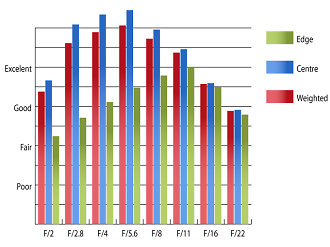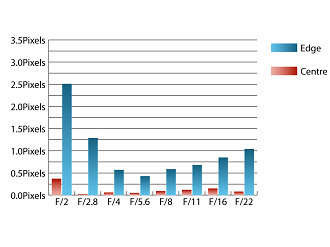Sony FE 28mm f/2 Review
Sony FE 28mm f/2 Performance
Sharpness is already very good in the centre of the frame at maximum aperture. Towards the edges of the frame performance is only fair at maximum aperture, gradually improving as the lens is stopped down to f/11, where clarity reaches excellent levels. Sharpness in the centre of the frame is outstanding between f/2.8 and f/11.
How to read our charts
The blue column represents readings from the centre of the picture frame at the various apertures and the green is from the edges. Averaging them out gives the red weighted column.The scale on the left side is an indication of actual image resolution. The taller the column, the better the lens performance. Simple.
For this review, the lens was tested on a Sony Alpha 7R using Imatest.
Chromatic aberrations are quite high, towards the edges of the frame at maximum aperture with fringing exceeding 2.5 pixel widths. This level of fringing may be visible along high contrast edges placed near the edges of the frame. Stopping down improves control of fringing with it falling below one-pixel width between f/4 and f/16.
How to read our charts
Chromatic aberration is the lens' inability to focus on the sensor or film all colours of visible light at the same point. Severe chromatic aberration gives a noticeable fringing or a halo effect around sharp edges within the picture. It can be cured in software.Apochromatic lenses have special lens elements (aspheric, extra-low dispersion etc) to minimize the problem, hence they usually cost more.
For this review, the lens was tested on a Sony Alpha 7R using Imatest.
Falloff of illumination towards the corners of the frame is quite pronounced, although not atypical for the kind of lens. At maximum aperture the corners of the frame are 3.25 stops darker than the image centre with visually uniform illumination being achieved with the lens stopped down to f/5.6 or beyond.
Distortion is very well controlled with only 0.175% pincushion distortion being detected by Imatest. If you require absolutely straight lines, you'll be glad to know that the distortion pattern is uniform across the frame, which should make applying correction in image editing software afterwards a doddle.
The supplied lens hood does a decent job of shielding the lens from extraneous light that may cause issues with flare. The lens is quite resistant to flare although contrast can be noticeably reduced when shooting into the light. The bayonet fitting that the lens hoods attaches with can also accept a couple of dedicated wide angle converters. One provides a 21mm equivalent field of view and the other produces a diagonal fisheye effect and both are available separately.
Value For Money
This lens can be picked up for around £390, which seems very reasonable for a fast aperture prime lens. There are no direct alternatives covering a similar range for Sony full-frame mirrorless cameras at the moment as Sony has a virtual monopoly on directly compatible lenses. For the sake of comparison, Nikon's AF-S 28mm f/1.8G lens costs around £500.
Add your message
Please login here or if you've not registered, you can register here. Registering is safe, quick and free.
photodo Stats
428 MTF tests
74 in-depth photodo reviews
100+ users join each day
Help the lens community by reviewing or rating a lens today via our lens search
Latest Lens Reviews
- Chinon 28mm f/2.8 Vintage Lens Review
- Canon EF 70-200mm f/4L IS II USM Lens Review
- Samyang AF 85mm f/1.4 EF Review
- Sigma 70mm f/2.8 DG Macro Art Review
- Samyang AF 24mm f/2.8 FE Review
- Meike 50mm f/1.7 Review
- Tamron 70-210mm f/4 Di VC USD Review
- Lensbaby Burnside 35mm f/2.8 Review
- Asahi Super Takumar 50mm f/1.4 Review
- Asahi Super-Multi-Coated Takumar 135mm f/3.5 Review


